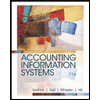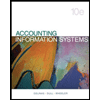
INT.ACCT. LL W/CONNECT+PROCTORIO PLUS
10th Edition
ISBN: 9781266374395
Author: SPICELAND
Publisher: MCG
expand_more
expand_more
format_list_bulleted
Question
Chapter 20, Problem 20.11DMP
To determine
Inventory error:
Inventory errors are sometimes caused by making mistake in physical count, in pricing the inventory correctly, or in recognizing the transfer of title for the goods in transit. These inventory errors affect both the income statement as well as
To Discuss: The reason behind these steps required to account for the error correction.
Expert Solution & Answer
Want to see the full answer?
Check out a sample textbook solution
Students have asked these similar questions
Suppose the required reserve ratio is 0.20 and individuals hold no cash. Total bank deposits are $150 million, and the banks hold $40 million in reserves. How much more money can the bank create if it does not hold excess reserves? Help
What will the book value of this purchase
Solve this
Chapter 20 Solutions
INT.ACCT. LL W/CONNECT+PROCTORIO PLUS
Ch. 20 - Prob. 20.1QCh. 20 - There are three basic accounting approaches to...Ch. 20 - Prob. 20.3QCh. 20 - Lynch Corporation changes from the...Ch. 20 - Sugarbaker Designs Inc. changed from the FIFO...Ch. 20 - Most changes in accounting principles are recorded...Ch. 20 - Southeast Steel, Inc., changed from the FIFO...Ch. 20 - Prob. 20.8QCh. 20 - Its not easy sometimes to distinguish between a...Ch. 20 - For financial reporting, a reporting entity can be...
Ch. 20 - Prob. 20.11QCh. 20 - Describe the process of correcting an error when...Ch. 20 - Prob. 20.13QCh. 20 - If it is discovered that an extraordinary repair...Ch. 20 - Prob. 20.15QCh. 20 - Prob. 20.5ECh. 20 - FASB codification research LO202 Access the FASB...Ch. 20 - Classifying accounting changes LO201 through...Ch. 20 - Classifying accounting changes and errors LO201...Ch. 20 - Prob. 20.3DMPCh. 20 - Analysis Case 204 Change in inventory methods;...Ch. 20 - Prob. 20.11DMP
Knowledge Booster
Learn more about
Need a deep-dive on the concept behind this application? Look no further. Learn more about this topic, accounting and related others by exploring similar questions and additional content below.Similar questions
- Value of the ending inventory under variable costing would be?arrow_forwardSolve thisarrow_forwardPortland Waxworks budgeted production of 46,000 wax lanterns for the year. Each lantern requires dipping. Assume that 12 minutes are required to dip each lantern. If dipping labor costs $14.50 per hour, determine the direct labor cost budget for the year.arrow_forward
- Suppose the required reserve ratio is 0.20 and individuals hold no cash. Total bank deposits are $150 million, and the banks hold $40 million in reserves. How much more money can the bank create if it does not hold excess reserves?arrow_forwardSolve this general accounting problemarrow_forwardOn January 1, 2025, Wages Payable was $47,000. Wages Expenses for 2025 totaled $453,000. The ending balance of Wages Payable was $59,000. What is the amount of cash paid for wages in 2025?arrow_forward
- Paxwell Industries uses a standard costing system that allows 3 pounds of direct materials for one finished unit. During November, the company purchased 50,000 pounds of direct materials for $275,000 and manufactured 15,000 finished units. The standard direct materials cost allowed for the units manufactured is $180,000. The performance report shows that Paxwell has an unfavorable direct materials usage variance of $6,000. Also, the company records any price variance for materials at the time of purchase. What was the number of pounds of direct materials used to produce November's output?arrow_forwardKendrick Manufacturing Corp. (KMC) has total assets of $600 million, $80 million of which are cash. It has total debt of $250 million. If KMC repurchases $30 million of its stock, what changes will occur on its balance sheet? What will its new leverage ratio be? Please provide the accurate answer to this financial accounting problem using valid techniques.arrow_forwardNot use ai solution please and accounting questionarrow_forward
arrow_back_ios
SEE MORE QUESTIONS
arrow_forward_ios
Recommended textbooks for you
 Accounting Information SystemsFinanceISBN:9781337552127Author:Ulric J. Gelinas, Richard B. Dull, Patrick Wheeler, Mary Callahan HillPublisher:Cengage Learning
Accounting Information SystemsFinanceISBN:9781337552127Author:Ulric J. Gelinas, Richard B. Dull, Patrick Wheeler, Mary Callahan HillPublisher:Cengage Learning Auditing: A Risk Based-Approach (MindTap Course L...AccountingISBN:9781337619455Author:Karla M Johnstone, Audrey A. Gramling, Larry E. RittenbergPublisher:Cengage Learning
Auditing: A Risk Based-Approach (MindTap Course L...AccountingISBN:9781337619455Author:Karla M Johnstone, Audrey A. Gramling, Larry E. RittenbergPublisher:Cengage Learning Corporate Financial AccountingAccountingISBN:9781305653535Author:Carl Warren, James M. Reeve, Jonathan DuchacPublisher:Cengage Learning
Corporate Financial AccountingAccountingISBN:9781305653535Author:Carl Warren, James M. Reeve, Jonathan DuchacPublisher:Cengage Learning Financial & Managerial AccountingAccountingISBN:9781285866307Author:Carl Warren, James M. Reeve, Jonathan DuchacPublisher:Cengage Learning
Financial & Managerial AccountingAccountingISBN:9781285866307Author:Carl Warren, James M. Reeve, Jonathan DuchacPublisher:Cengage Learning Pkg Acc Infor Systems MS VISIO CDFinanceISBN:9781133935940Author:Ulric J. GelinasPublisher:CENGAGE L
Pkg Acc Infor Systems MS VISIO CDFinanceISBN:9781133935940Author:Ulric J. GelinasPublisher:CENGAGE L Individual Income TaxesAccountingISBN:9780357109731Author:HoffmanPublisher:CENGAGE LEARNING - CONSIGNMENT
Individual Income TaxesAccountingISBN:9780357109731Author:HoffmanPublisher:CENGAGE LEARNING - CONSIGNMENT

Accounting Information Systems
Finance
ISBN:9781337552127
Author:Ulric J. Gelinas, Richard B. Dull, Patrick Wheeler, Mary Callahan Hill
Publisher:Cengage Learning

Auditing: A Risk Based-Approach (MindTap Course L...
Accounting
ISBN:9781337619455
Author:Karla M Johnstone, Audrey A. Gramling, Larry E. Rittenberg
Publisher:Cengage Learning

Corporate Financial Accounting
Accounting
ISBN:9781305653535
Author:Carl Warren, James M. Reeve, Jonathan Duchac
Publisher:Cengage Learning

Financial & Managerial Accounting
Accounting
ISBN:9781285866307
Author:Carl Warren, James M. Reeve, Jonathan Duchac
Publisher:Cengage Learning

Pkg Acc Infor Systems MS VISIO CD
Finance
ISBN:9781133935940
Author:Ulric J. Gelinas
Publisher:CENGAGE L

Individual Income Taxes
Accounting
ISBN:9780357109731
Author:Hoffman
Publisher:CENGAGE LEARNING - CONSIGNMENT
Accounting Changes and Error Analysis: Intermediate Accounting Chapter 22; Author: Finally Learn;https://www.youtube.com/watch?v=c2uQdN53MV4;License: Standard Youtube License